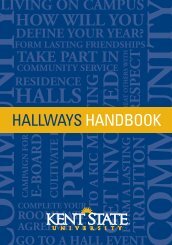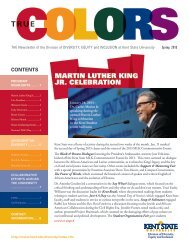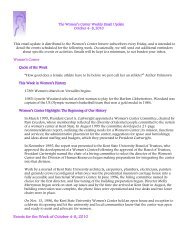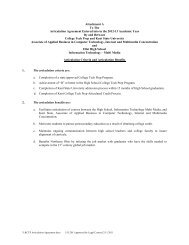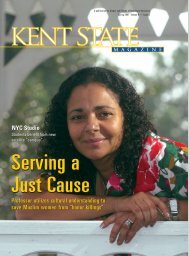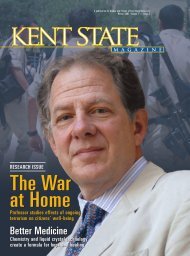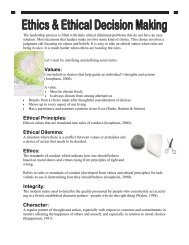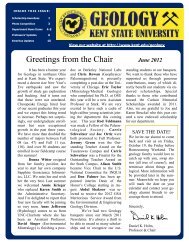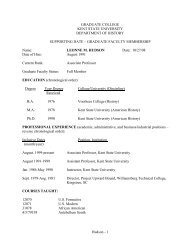Lester Lefton Lester Lefton - Kent State University
Lester Lefton Lester Lefton - Kent State University
Lester Lefton Lester Lefton - Kent State University
You also want an ePaper? Increase the reach of your titles
YUMPU automatically turns print PDFs into web optimized ePapers that Google loves.
Dr. Spiros Margetis<br />
Historians understand that knowing<br />
where we are and where we are going<br />
requires a thorough examination of<br />
where we have been. But in the case of<br />
<strong>Kent</strong> <strong>State</strong> <strong>University</strong> physicists, looking<br />
at past centuries — or even millennia<br />
— wouldn’t suffice. To achieve their<br />
aims, they needed to peer back at the<br />
origin of the universe, nearly 14 billion<br />
years ago.<br />
The work of an international collaboration<br />
involving <strong>Kent</strong> <strong>State</strong> physics<br />
professors and graduate students —<br />
though it doesn’t involve time travel —<br />
may seem to some the stuff of science<br />
fiction. The researchers have successfully<br />
recreated the material essence of the universe<br />
as it would have been mere microseconds<br />
after the Big Bang, discovering<br />
evidence for the existence of a new phase<br />
of matter in the process.<br />
“This project gives us information<br />
about how the universe looked a millionth<br />
of a second after its beginning,”<br />
says Dr. Spiros Margetis, <strong>Kent</strong> <strong>State</strong><br />
associate professor of physics.<br />
The new form of matter is a dense,<br />
fluid-like state consisting of quarks (the<br />
ultimate building blocks of every atomic<br />
nucleus) and gluons (the particles responsible<br />
for holding the quarks together).<br />
One spoonful weighs about as much as all<br />
the water in Lake Erie, Margetis says.<br />
This insight, which allows scientists<br />
to study matter in its earliest form, comes<br />
from an experiment carried out at the<br />
Relativistic Heavy Ion Collider (RHIC),<br />
a giant atom smasher with a circumference<br />
of 2.4 miles, located at Brookhaven<br />
National Lab in New York. More than<br />
In the<br />
Beginning<br />
15 years ago, <strong>Kent</strong> <strong>State</strong> was one of six<br />
original groups that founded the experiment,<br />
which has since grown to include<br />
500-plus individuals from 52 institutions,<br />
representing 12 countries.<br />
Since 2000, the collaboration has<br />
produced more than 50 papers in peerreviewed<br />
journals, and many more are<br />
in the pipeline. <strong>Kent</strong> <strong>State</strong> has played a<br />
prominent part in approximately 10 of<br />
these, meaning 10 papers were based<br />
in whole or in part on work taken from<br />
the doctoral dissertations of <strong>Kent</strong> <strong>State</strong><br />
students working on the project.<br />
At the fundamental level, the research<br />
helps us understand what the universe<br />
is made of and how the early universe<br />
evolved into the universe as we now<br />
know it. In addition, the development of<br />
the equipment and techniques necessary<br />
to conduct the research at RHIC pushes<br />
forward the boundaries of technology<br />
and provides advanced training for young<br />
researchers.<br />
A matter of universal proportion<br />
By Lisa Lambert, M.A. ’05<br />
Presently, nuclear techniques are used<br />
extensively in medical imaging, cancer<br />
radiotherapy and nondestructive analysis<br />
of steel, oil samples, ceramics and many<br />
other materials. As our understanding,<br />
equipment and techniques advance, we<br />
are able to improve noninvasive screening<br />
for many diseases, better treat cancerous<br />
tumors and do material analyses, for<br />
example.<br />
“We live in a very high-tech world,<br />
and it’s important we continue to train<br />
people to contribute to the development<br />
of state-of-the-art technology,” says<br />
Dr. Bryon Anderson, <strong>Kent</strong> <strong>State</strong> professor<br />
of physics. “The students working at<br />
RHIC obtain this kind of training.”<br />
The American Institute of Physics ranked<br />
the discovery as the top physics story<br />
for 2005.<br />
For more information about the<br />
collaboration, visit www.kent.edu/<br />
magazine.<br />
p a g e1 1



